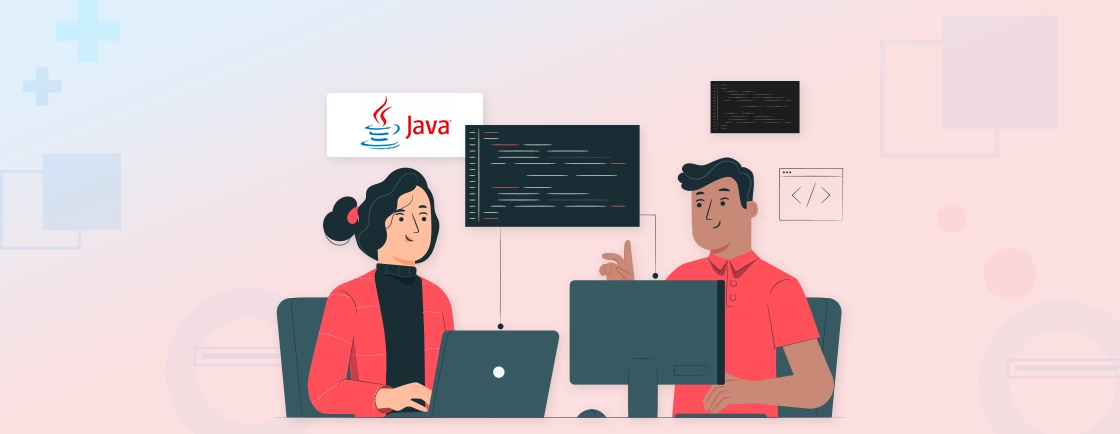Table of Contents
When you’re working with complex systems in Java, it’s easy to get overwhelmed by the many moving parts that need to interact. That’s when you need design patterns to simplify things and for keeping things neat and manageable. But what exactly is it, and why should you care?
In this blog, we’re going to break down the Java Facade Pattern with expert inputs from our professional Java developers. We’ll discuss what it does, how it works, and, most importantly, show you how it can be applied with real-world examples. We also understand how the Facade Pattern can make your code cleaner, easier to maintain, and more user-friendly. So, let’s get started.
What is Java Facade Pattern?
The Facade Pattern is one of those design patterns that make life a lot easier when dealing with complex systems. In simple terms, it’s like a wrapper that simplifies a complicated interface into something much easier to use.
Imagine you’re at a hotel. Instead of dealing with all the individual departments—housekeeping, room service, maintenance—you talk to one person at the front desk. They handle everything for you. That’s exactly how the Facade Pattern works in programming.
In Java, you often have many classes and modules that need to work together. Without a facade, you’d have to deal with each class separately, which can get messy and hard to manage. A facade gives you a single, simplified interface to interact with all those classes. It hides the complexity, making your code more readable and maintainable.
Here’s how it works:
- Without the Facade: You directly interact with each class. If one class changes, you might need to update several places in your code where it’s used.
- With the Facade: You interact with just one class (the facade). It takes care of calling the necessary classes behind the scenes. If a class changes, only the facade might need an update, which keeps everything else safe.
So, the Facade Pattern doesn’t change the way your system works—it just gives you an easier way to interact with it.
Advantages of Java Facade Pattern
The Java Facade Pattern isn’t just about making things easier—it brings some real benefits to your code. Here are a few of the top advantages:
- Simplifies Complex Systems: The biggest advantage of the Facade Pattern is that it hides complexity. When you’re dealing with a system that has many classes and interactions, the facade gives you a single point of contact. Instead of managing lots of moving parts, you interact with one simple interface.
- Improves Code Readability: Because the facade consolidates all the interactions, your code becomes cleaner and easier to read. You don’t have to worry about which class does what. Everything you need is bundled together in one simple place, making it much easier for other developers (or even yourself) to understand.
- Reduces Dependencies: Without the facade, your classes may need to directly communicate with each other. This creates tight dependencies between different parts of your code. The facade reduces these dependencies by giving each part a simpler interface to work with, making your code less fragile and easier to change.
- Easier Maintenance: If something changes in the underlying system, you only need to update the facade. Since other parts of your code interact with the facade and not directly with the system, this means fewer places to update. It makes maintaining and scaling your application much more manageable.
- Promotes Loose Coupling: The Facade Pattern helps keep your code loosely coupled. This means that classes don’t need to know the internal details of each other. They just rely on the facade to do the work, which makes your system more flexible and less prone to bugs when changes happen.
In short, the Java Facade Pattern offers several key benefits. It reduces dependencies between classes, promotes loose coupling, and makes maintenance easier since updates are confined to the facade.
Our Java Web Development Services often leverage such patterns to build maintainable and future-ready applications for businesses across industries.
Disadvantages of Java Facade Pattern
While the Java Facade Pattern is super helpful, it’s not without its drawbacks. Here are some things to consider before using it:
- Can Hide Too Much Detail: The Facade Pattern hides complexity, but sometimes, that’s not always a good thing. If you need to work with specific features or fine-tune details in the underlying system, the facade might make that harder. You could end up missing out on important functionality because the facade oversimplifies things.
- Adds an Extra Layer: By introducing a facade, you’re adding another layer between your code and the complex system. While this is usually helpful, it can add unnecessary overhead if the system isn’t that complicated to begin with. In small projects, this might just be an extra step that doesn’t bring much value.
- Can Limit Flexibility: Since the facade simplifies the interface, you may end up working with fewer options. If you need to access more advanced or specific features from the underlying classes, the facade might not provide the flexibility you need. You might have to bypass the facade, which defeats its purpose.
- Potential for Overuse: Sometimes, developers get carried away and use the Facade Pattern even when it’s not needed. If your system isn’t that complicated, forcing a facade on it can create unnecessary complexity. It’s important to use this pattern when it truly adds value and not just for the sake of using it.
Simply put, Java Facade Pattern has some drawbacks to consider. It can hide too much detail, making it harder to access specific features. It also adds an extra layer, which may not be necessary for simpler systems.
How to Implement Facade Pattern in Java?
Implementing the Facade Pattern in Java is pretty straightforward. Follow the steps given below to do it:
Step 1. Define the Subsystems
First, identify the complex subsystems you’re working with. These are the classes or components that are difficult to interact with directly. Let’s say you have a few classes that deal with different parts of a system, like a PaymentService, InventoryService, and ShippingService.
Step 2. Create the Facade Class
Next, you create a facade class that will provide a simplified interface to interact with those subsystems. This class will have methods that combine the complex functionality of the subsystems into easy-to-use methods for the client.
public class OrderFacade {
private PaymentService paymentService;
private InventoryService inventoryService;
private ShippingService shippingService;
public OrderFacade() {
paymentService = new PaymentService();
inventoryService = new InventoryService();
shippingService = new ShippingService();
}
public void placeOrder(Order order) {
if (inventoryService.checkAvailability(order)) {
paymentService.processPayment(order);
shippingService.shipOrder(order);
System.out.println("Order placed successfully!");
} else {
System.out.println("Order cannot be placed. Items are out of stock.");
}
}
}
3. Simplify the Client Interaction
Now, instead of the client needing to interact with the PaymentService, InventoryService, and ShippingService directly, they just call the OrderFacade. The facade will handle all the necessary interactions for them. This makes the client’s code simpler and cleaner.
public class Main {
public static void main(String[] args) {
Order order = new Order(); // assume it's already filled with necessary details
OrderFacade orderFacade = new OrderFacade();
orderFacade.placeOrder(order);
}
}
4. Keep the System Unaware of the Facade
The subsystems (PaymentService, InventoryService, ShippingService) don’t need to know anything about the facade. They just perform their individual tasks and the facade manages how they interact.
With these simple steps, you can effectively implement the Facade Pattern in Java applications, simplifying complex systems and making client interactions much cleaner and easier to manage.
When to Use Java Facade Pattern?
The Java Facade Pattern is super useful in certain situations. Here’s when you should consider using it:
- When Dealing with a Complex System: If your system has many classes that interact with each other, the facade can help simplify things. It provides a single point of contact, so you don’t have to deal with all the complicated details each time you want to use the system.
- When You Want to Make Your Code More Readable: If you find your code hard to understand because there are too many moving parts, the facade can tidy things up. It reduces clutter and gives you a clear and easy-to-use interface to work with.
- When You Need to Hide Implementation Details: Sometimes, you don’t want other parts of your program to be concerned with how things work behind the scenes. The facade helps by hiding the internal complexity, allowing you to change things without affecting the rest of the code.
- When You Want to Decouple Code: If you want to reduce dependencies between classes, the facade is perfect. It gives you a way to interact with the system without directly tying your code to the inner workings of each class, making the system more flexible and easier to maintain.
- When You’re Integrating Multiple Subsystems: If you’re working with multiple subsystems that need to communicate, the facade can help manage that communication. It acts as a bridge between all the different parts of your system, making integration smoother and easier to handle.
In short, use the Facade Pattern when you want to simplify complex systems, improve readability, hide details, and make your code more flexible and maintainable.
Key Points to Consider for Facade Design Pattern
Some important things to keep in mind when working with the Facade Design Pattern:
- Use It When the System Becomes Complex: You can apply the Facade Pattern at any point during development. It’s most useful when the number of interfaces grows, and the system starts getting complicated. If the system has too many parts to manage, the facade helps by simplifying the way the client interacts with it.
- Use Facade for Similar Interfaces: The facade is best used when you have multiple similar interfaces. Instead of forcing the client to interact with several different interfaces that do similar jobs, the facade provides a single, unified interface to make everything simpler and more organized.
- Facade is a Helper for Client Applications: The facade is like a helper that simplifies things for the client code. It doesn’t hide the subsystem interfaces completely. Instead, it makes it easier for the client to interact with the system. Whether you decide to use a facade or not depends on the needs of your client code.
- Subsystem Interfaces Don’t Know About the Facade: The subsystems that the facade interacts with don’t have any idea about the facade itself. They don’t reference the facade, meaning they stay separate. The facade simply acts as a bridge between the client and the subsystem, without the subsystem needing to worry about the facade at all.
- Pairing Facade with Factory Pattern: For an even better interface, you can combine the Facade Pattern with the Factory Pattern. The Factory can help create objects in a way that makes the overall system more flexible and easier for the client to use, while the facade keeps everything tidy and easy to access.
To sum up, you can make the most of the Facade Design Pattern, ensuring your system remains simple, organized, and easy to maintain while offering a clean interface to the client.
Real-World Applications of Java Facade Pattern
The Facade Pattern isn’t just something you use in your own projects—it’s also widely used in popular Java libraries and frameworks to make complex systems easier to use. Let’s look at some real-world examples:
1. Java’s java.net.URL
The URL class in Java simplifies the process of working with web addresses. Behind the scenes, it interacts with many complex components like handling network connections, encoding URLs, and parsing strings. However, you only need to work with the URL class, which provides a simple interface to do things like opening a connection to a website or fetching data from a URL. It hides all the complex networking stuff and makes it easy for you to interact with web addresses.
URL url = new URL("https://example.com");
HttpURLConnection connection = (HttpURLConnection) url.openConnection();
2. JavaServer Faces (JSF) – javax.faces.context.FacesContext
In web development with Java, JSF uses the Facade Pattern to simplify working with web requests and responses. The FacesContext class provides a unified interface for handling the current request, response, and other necessary components. Instead of dealing with multiple lower-level classes, JSF gives you FacesContext to interact with the entire web context in one place.
FacesContext facesContext = FacesContext.getCurrentInstance(); facesContext.getExternalContext().getRequestMap().put("username", "JohnDoe");
3. Spring Framework
In the Spring Framework, facades are used to simplify access to various complex APIs. For example, the ApplicationContext in Spring serves as a facade for interacting with the entire Spring container. It hides the complexity of object creation, dependency injection, and other backend processes, offering a simple interface for managing beans and services.
ApplicationContext context = new ClassPathXmlApplicationContext("beans.xml"); MyService myService = (MyService) context.getBean("myService");
4. Hibernate ORM
Hibernate is another example where the Facade Pattern is used. It simplifies database interactions by providing an easy-to-use interface for performing CRUD (Create, Read, Update, Delete) operations. You don’t have to interact with complex SQL queries and database connections directly. Instead, Hibernate offers a simple API to handle all the database-related tasks.
Session session = sessionFactory.openSession();
Transaction transaction = session.beginTransaction();
session.save(myEntity);
transaction.commit();
5. Logging Frameworks (e.g., Log4j)
Logging libraries like Log4j use facades to simplify logging configuration and usage. Instead of dealing with the complexity of configuring multiple loggers or handling different logging levels, the facade provides a single interface for logging messages across the application.
Logger logger = LogManager.getLogger(MyClass.class);
logger.info("This is an info message.");
logger.error("This is an error message.");
In short, these examples show how the Facade Pattern is used in real-world Java libraries and frameworks to simplify complex systems and make them easier for developers to work with. It helps abstract away the underlying complexity, so you can focus on getting things done with minimal hassle.
FAQs on Java Facade Pattern
What is the difference between facade and factory pattern?
– The Facade Pattern simplifies complex systems by providing a single, unified interface to interact with multiple subsystems.
– The Factory Pattern helps create objects without exposing the creation logic to the client. It provides an interface for creating objects in a way that allows flexibility.
So, the facade is about simplifying interactions, while the factory is about creating objects.
What is the alternative to the facade pattern?
An alternative to the Facade Pattern is using Direct Access to Subsystems. Instead of using a facade to simplify things, you can directly interact with each subsystem. However, this can lead to more complex and harder-to-maintain code as the system grows.
What is a common misuse of the Facade pattern?
A common misuse of the Facade Pattern is using it when the system is not complex enough. If the system is simple, forcing a facade onto it can add unnecessary layers and make the code harder to understand instead of simplifying it.
Let’s Summarize
The Java Facade Pattern is a useful tool that can make your interactions with complex systems easy. By providing a unified interface to multiple subsystems, it hides complexity and makes your code easier to manage, read, and maintain. Whether you’re working on a large project with many moving parts or just want to improve code clarity, using the Facade Pattern can make a significant difference.
The Facade Pattern is widely used in Java libraries and frameworks to abstract complexity. It’s a great way to keep your code flexible, maintainable, and free of unnecessary dependencies. If you’re ready to put these design patterns to work in your projects, you can hire Java developers from our team to build scalable, enterprise-grade applications tailored to your needs.
Strengthen Your Java Solutions
Dive into comprehensive tutorials and best practices to enhance your Java development skills.




